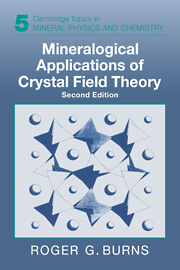Book contents
- Frontmatter
- Contents
- Preface to the first edition
- Preface to the second edition
- 1 Introduction
- 2 Outline of crystal field theory
- 3 Energy level diagrams and crystal field spectra of transition metal ions
- 4 Measurements of absorption spectra of minerals
- 5 Crystal field spectra of transition metal ions in minerals
- 6 Crystal chemistry of transition metal-bearing minerals
- 7 Thermodynamic properties influenced by crystal field energies
- 8 Trace element geochemistry: distribution of transition metals in the Earth's crust
- 9 Mantle geochemistry of the transition elements: optical spectra at elevated temperatures and pressures
- 10 Remote-sensing compositions of planetary surfaces: applications of reflectance spectra
- 11 Covalent bonding of the transition elements
- Appendices
- References
- Subject index
3 - Energy level diagrams and crystal field spectra of transition metal ions
Published online by Cambridge University Press: 23 November 2009
- Frontmatter
- Contents
- Preface to the first edition
- Preface to the second edition
- 1 Introduction
- 2 Outline of crystal field theory
- 3 Energy level diagrams and crystal field spectra of transition metal ions
- 4 Measurements of absorption spectra of minerals
- 5 Crystal field spectra of transition metal ions in minerals
- 6 Crystal chemistry of transition metal-bearing minerals
- 7 Thermodynamic properties influenced by crystal field energies
- 8 Trace element geochemistry: distribution of transition metals in the Earth's crust
- 9 Mantle geochemistry of the transition elements: optical spectra at elevated temperatures and pressures
- 10 Remote-sensing compositions of planetary surfaces: applications of reflectance spectra
- 11 Covalent bonding of the transition elements
- Appendices
- References
- Subject index
Summary
A variety of selection rules derived from quantum mechanics governs the intensity of the various types of absorption phenomena.
– – The rules can be bent when ions get together.
G. R. Rossman, Rev. Mineral, 18, 214 (1988)Introduction
In the previous chapter it was shown how electrostatic fields produced by anions or negative ends of dipolar ligands belonging to coordination sites in a crystal structure split the 3d orbitals of a transition metal ion into two or more energy levels. The magnitude of these energy separations, or crystal field splittings, depend on the valence of the transition metal ion and the symmetry, type and distances of ligands surrounding the cation. The statement was made in 2.8 that separations between the 3d orbital energy levels may be evaluated from measurements of absorption spectra in the visible to near-infrared region. The origins of such crystal field spectra, also termed d–d spectra and optical spectra, are described in this chapter. Later chapters focus on measurements and applications of crystal field spectra of transition metal-bearing minerals.
Units in absorption spectra
When light is passed through a compound or mineral containing a transition metal ion, it is found that certain wavelengths are absorbed, often leading to coloured transmitted light. One cause of such absorption of light is the excitation of electrons between the split 3d orbital energy levels. Measurements of the intensity of light incident on and transmitted through the transition metalbearing phase produces data for plotting an absorption spectrum.
- Type
- Chapter
- Information
- Mineralogical Applications of Crystal Field Theory , pp. 44 - 86Publisher: Cambridge University PressPrint publication year: 1993
- 1
- Cited by



